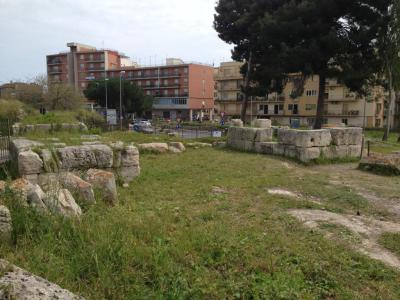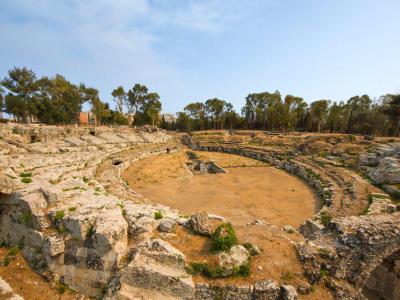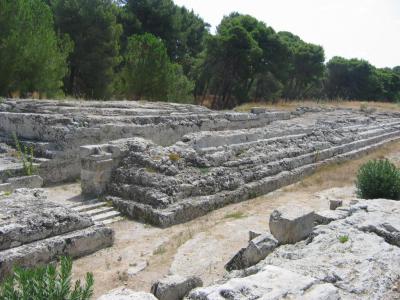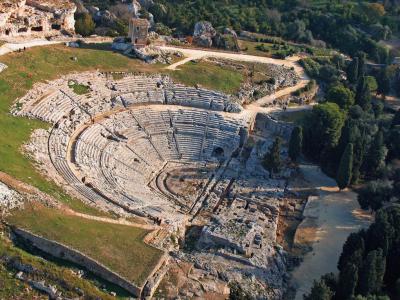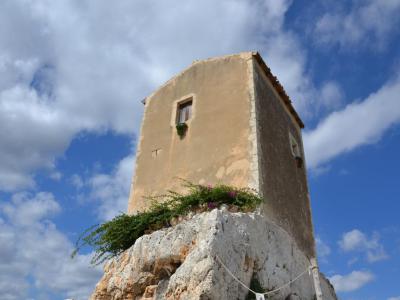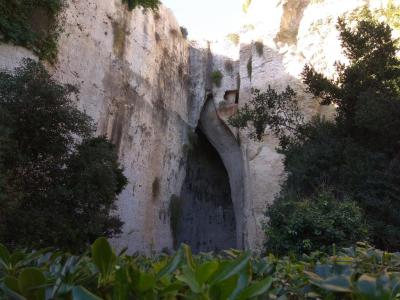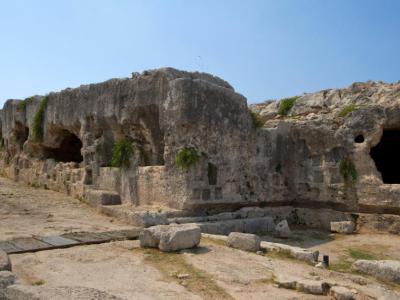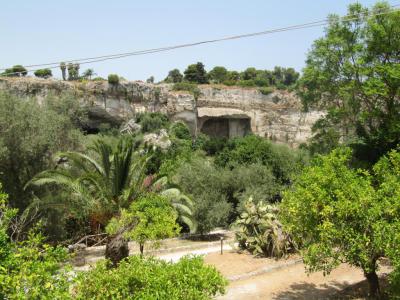Neapolis Archaeological Park Walk (Self Guided), Syracuse
For those keen on ancient history, Syracuse's main attraction lies within its Neapolis Archaeological Park. Spread across a vast area, this historical site contains a variety of fascinating landmarks, each with its own unique story.
Our first stop on this walk is the Augustan Arch (Arco Augusteo), the majestic archway built during the reign of Emperor Augustus. Nearby, you'll find the Roman Amphitheater (Anfiteatro Romano), dating back to the 2nd century. Originally used for gladiatorial contests and horse races, it suffered significant destruction in the 16th century at the hands of the Spaniards, who repurposed it as a quarry.
To the west of the amphitheater stands the Altar of Hiero II (Ara di Ierone II), a monolithic sacrificial structure from the 3rd century BC dedicated to the ancient Greek tyrant Hiero II. This impressive altar had the capacity to sacrifice up to 450 oxen simultaneously.
Moving towards the Christian heritage of the city, the Church of San Nicolò ai Cordari stands as an impressive testament to the evolution of Syracuse over the centuries.
One of the most iconic sites within the park is the Greek Theatre (Teatro Greco), a remarkable ancient amphitheater with breathtaking acoustics that once hosted the first performances of Aeschylus's tragedies, including "The Persians," with the playwright himself in attendance.
Nearby, the Mills of Galerme (Mulini di Galerme) showcase ancient industrial processes, providing insights into daily life in antiquity.
Further exploration leads to the mysterious Ear of Dionysius (Orecchio di Dionisio), a cave with unique acoustic properties, and the enchanting Nymphaeum Cave (Grotta del Ninfeo), an underground grotto dedicated to water nymphs.
Strolling along the Street of the Tombs (Via dei Sepolcri), you'll encounter elaborate burial sites that offer a glimpse into the funerary practices of ancient Syracuse. Lastly, the Latomia of Paradise (Latomia del Paradiso), a vast limestone quarry turned into a beautiful garden, adds a serene and picturesque touch to the park.
Visiting Neapolis Archaeological Park unveils the layers of history that have shaped Syracuse. If you're a history enthusiast, you will love it! But even if you're simply seeking a serene place to explore, this park can offer you just as much entertainment and culturally enriching experience. So, don't hesitate. Take this self-guided tour and enjoy it!
Our first stop on this walk is the Augustan Arch (Arco Augusteo), the majestic archway built during the reign of Emperor Augustus. Nearby, you'll find the Roman Amphitheater (Anfiteatro Romano), dating back to the 2nd century. Originally used for gladiatorial contests and horse races, it suffered significant destruction in the 16th century at the hands of the Spaniards, who repurposed it as a quarry.
To the west of the amphitheater stands the Altar of Hiero II (Ara di Ierone II), a monolithic sacrificial structure from the 3rd century BC dedicated to the ancient Greek tyrant Hiero II. This impressive altar had the capacity to sacrifice up to 450 oxen simultaneously.
Moving towards the Christian heritage of the city, the Church of San Nicolò ai Cordari stands as an impressive testament to the evolution of Syracuse over the centuries.
One of the most iconic sites within the park is the Greek Theatre (Teatro Greco), a remarkable ancient amphitheater with breathtaking acoustics that once hosted the first performances of Aeschylus's tragedies, including "The Persians," with the playwright himself in attendance.
Nearby, the Mills of Galerme (Mulini di Galerme) showcase ancient industrial processes, providing insights into daily life in antiquity.
Further exploration leads to the mysterious Ear of Dionysius (Orecchio di Dionisio), a cave with unique acoustic properties, and the enchanting Nymphaeum Cave (Grotta del Ninfeo), an underground grotto dedicated to water nymphs.
Strolling along the Street of the Tombs (Via dei Sepolcri), you'll encounter elaborate burial sites that offer a glimpse into the funerary practices of ancient Syracuse. Lastly, the Latomia of Paradise (Latomia del Paradiso), a vast limestone quarry turned into a beautiful garden, adds a serene and picturesque touch to the park.
Visiting Neapolis Archaeological Park unveils the layers of history that have shaped Syracuse. If you're a history enthusiast, you will love it! But even if you're simply seeking a serene place to explore, this park can offer you just as much entertainment and culturally enriching experience. So, don't hesitate. Take this self-guided tour and enjoy it!
How it works: Download the app "GPSmyCity: Walks in 1K+ Cities" from Apple App Store or Google Play Store to your mobile phone or tablet. The app turns your mobile device into a personal tour guide and its built-in GPS navigation functions guide you from one tour stop to next. The app works offline, so no data plan is needed when traveling abroad.
Neapolis Archaeological Park Walk Map
Guide Name: Neapolis Archaeological Park Walk
Guide Location: Italy » Syracuse (See other walking tours in Syracuse)
Guide Type: Self-guided Walking Tour (Sightseeing)
# of Attractions: 10
Tour Duration: 2 Hour(s)
Travel Distance: 2.1 Km or 1.3 Miles
Author: DanaOffice
Sight(s) Featured in This Guide:
Guide Location: Italy » Syracuse (See other walking tours in Syracuse)
Guide Type: Self-guided Walking Tour (Sightseeing)
# of Attractions: 10
Tour Duration: 2 Hour(s)
Travel Distance: 2.1 Km or 1.3 Miles
Author: DanaOffice
Sight(s) Featured in This Guide:
- Arco Augusteo (Augustan Arch)
- Anfiteatro Romano (Roman Amphitheater)
- Church of San Nicolò ai Cordari
- Ara di Ierone (Altar of Hiero II)
- Teatro Greco (Greek Theatre)
- Mulini di Galerme (Mills of Galerme)
- Orecchio di Dionisio (Ear of Dionysius)
- Grotta del Ninfeo (Nymphaeum Cave)
- Via dei Sepolcri (Street of the Tombs)
- Latomia del Paradiso (Latomia of Paradise)
1) Arco Augusteo (Augustan Arch)
The Augustan Arch of Syracuse is a remarkable Roman architectural structure dating back to the Augustan era, situated in the heart of the Neapolis Archaeological Park in Syracuse. This arch stands as a testament to the city's rich history and Roman heritage.
Excavations in the 1950s near the Roman amphitheater of Syracuse unveiled the remains of this splendid architectural work. The arch was designed with two pillars supporting a single-fornix arch, with its front oriented in an east-west direction. The grand dimensions of the arch are impressive, with a width of 10 meters, a depth of 6 meters, and an overall height of approximately 13 meters. The arch was constructed using opus sack as the internal core, while the exterior was adorned with opus quadratum, showcasing white limestone blocks, and maintaining a rustic ashlar finish.
The arch was built on a low plinth, and for both pylons, archaeologists identified three rows of elevated blocks, as well as four blocks from the fourth row in the southern pylon. The arch boasted a prominent main façade facing east, where it might have featured columns or corner pilasters, lending it an imposing and ornate appearance. In contrast, the western front, although simpler, likely did not have an applied order.
The arch underwent partial modifications at two key points in history. First, at the end of the 2nd century and the beginning of the 3rd century AD, alterations were made. Then, further modifications were made at the end of the 7th century AD, which involved raising the fornix floor and constructing a staircase on the eastern façade. These changes speak to the evolving use and significance of the arch over time.
The arch's strategic location was along a road flanked by private residential areas to the north and south. Situated a short distance to the east of the southern entrance to the amphitheatre, the Augustan Arch represents a captivating relic of the city's ancient past, offering a glimpse into its Roman heritage and the architectural prowess of the Augustan era.
Excavations in the 1950s near the Roman amphitheater of Syracuse unveiled the remains of this splendid architectural work. The arch was designed with two pillars supporting a single-fornix arch, with its front oriented in an east-west direction. The grand dimensions of the arch are impressive, with a width of 10 meters, a depth of 6 meters, and an overall height of approximately 13 meters. The arch was constructed using opus sack as the internal core, while the exterior was adorned with opus quadratum, showcasing white limestone blocks, and maintaining a rustic ashlar finish.
The arch was built on a low plinth, and for both pylons, archaeologists identified three rows of elevated blocks, as well as four blocks from the fourth row in the southern pylon. The arch boasted a prominent main façade facing east, where it might have featured columns or corner pilasters, lending it an imposing and ornate appearance. In contrast, the western front, although simpler, likely did not have an applied order.
The arch underwent partial modifications at two key points in history. First, at the end of the 2nd century and the beginning of the 3rd century AD, alterations were made. Then, further modifications were made at the end of the 7th century AD, which involved raising the fornix floor and constructing a staircase on the eastern façade. These changes speak to the evolving use and significance of the arch over time.
The arch's strategic location was along a road flanked by private residential areas to the north and south. Situated a short distance to the east of the southern entrance to the amphitheatre, the Augustan Arch represents a captivating relic of the city's ancient past, offering a glimpse into its Roman heritage and the architectural prowess of the Augustan era.
2) Anfiteatro Romano (Roman Amphitheater)
The Roman Amphitheater of Syracuse stands as a remarkable architectural creation from the early Roman imperial era, signifying the historical significance and grandeur of ancient Syracuse. Unlike other buildings in Neapolis, this amphitheater's orientation diverges from the norm and is believed to follow the urban plan created during the late classical age.
The road leading from the Acradina district, which reached the Neapolis, extended to the amphitheater. This road was designed to enter the Neapolis through a triumphal arch dating back to the Augustan era, which linked it to the arch of Susa. Between the arch and the amphitheater, there was a grand monumental fountain, supplied by a large, unidentified cistern. The amphitheater itself was fed by a large cistern located under the nearby church of San Nicola.
The amphitheater, which is largely excavated into the rock, utilized the slope of a rocky crag in the northeastern part of the construction. Unfortunately, little remains of the upper built section. Excavations led by the Duke of Serradifalco in 1839 brought this remarkable structure to light.
The monumental amphitheater boasts impressive dimensions, estimated to be approximately 140 meters in length and 119 meters in width. The monument features two entrances and is equipped with a complex system of stairs descending from the upper level on the exterior. The central arena features a large rectangular space, which was originally covered. An underground passage connects this area with the southern end of the monument, aligning with the entrance corridor. These underground works were essential for the machinery used during the shows held at the amphitheater.
The auditorium around the arena is elevated and defined by a high podium. A covered corridor with openings for access to the gladiator and beast arena runs behind the podium. Above this, the first steps were reserved for individuals of high rank. The blocks of the parapet bear inscriptions that offer historical insights. Radiating from the annular ambulatory, a series of radial passages allowed access to the various sectors of the auditorium. The Roman Amphitheater of Syracuse represents not only a significant historical relic but also a testament to the entertainment and cultural practices of the ancient Roman world.
The road leading from the Acradina district, which reached the Neapolis, extended to the amphitheater. This road was designed to enter the Neapolis through a triumphal arch dating back to the Augustan era, which linked it to the arch of Susa. Between the arch and the amphitheater, there was a grand monumental fountain, supplied by a large, unidentified cistern. The amphitheater itself was fed by a large cistern located under the nearby church of San Nicola.
The amphitheater, which is largely excavated into the rock, utilized the slope of a rocky crag in the northeastern part of the construction. Unfortunately, little remains of the upper built section. Excavations led by the Duke of Serradifalco in 1839 brought this remarkable structure to light.
The monumental amphitheater boasts impressive dimensions, estimated to be approximately 140 meters in length and 119 meters in width. The monument features two entrances and is equipped with a complex system of stairs descending from the upper level on the exterior. The central arena features a large rectangular space, which was originally covered. An underground passage connects this area with the southern end of the monument, aligning with the entrance corridor. These underground works were essential for the machinery used during the shows held at the amphitheater.
The auditorium around the arena is elevated and defined by a high podium. A covered corridor with openings for access to the gladiator and beast arena runs behind the podium. Above this, the first steps were reserved for individuals of high rank. The blocks of the parapet bear inscriptions that offer historical insights. Radiating from the annular ambulatory, a series of radial passages allowed access to the various sectors of the auditorium. The Roman Amphitheater of Syracuse represents not only a significant historical relic but also a testament to the entertainment and cultural practices of the ancient Roman world.
3) Church of San Nicolò ai Cordari
The Church of San Nicolò ai Cordari is a historic place of worship in Syracuse, with a rich history that reflects the city's diverse cultural and architectural heritage. This church, one of the earliest to be constructed in Syracuse, dates back to the Norman era, built shortly after the Arab rule in the Aretusea city.
The site of the present church holds historical significance, as it once housed an early Christian-era basilica-style religious building. In the Byzantine period, this church was transformed into an underground place of worship. Below the church, you can explore the so-called Roman Pool, which consists of large water tanks hewn from the stone of the Latomie. These ancient water conduits were originally used by the people of Syracuse during the Roman period to fill the Roman amphitheater, where nautical games and water fights took place.
In 1093, the church gained further prominence when it hosted the funeral of Count Giordano d'Altavilla, the son of the renowned Count Roger I of Sicily. The Normans dedicated the church to Saint Nicholas of Myra, the patron saint invoked to help expel the Arabs from Syracuse.
Over the centuries, as the population of Syracuse dwindled during various historical periods, including the Angevin, Spanish, Austrian, and Bourbon rule, the church was eventually deconsecrated and abandoned. The city's inhabitants concentrated within the fortified island of Ortigia, leading to the neglect of structures beyond its walls, including the church of San Nicolò.
In 1577, the church was granted to the cordari, artisans who crafted ropes and worked in the nearby Latomie of Neapolis. It was during this time that the church became known as the Church of San Nicolò dei Cordari, as it served the families of rope makers in Syracuse. The church subsequently had various uses, including as a grain warehouse, and during a plague outbreak around 1600, its cellars served as a mass grave.
Today, the church plays a vital role as the entrance to the Neapolis archaeological park. Inside, you'll find a small photographic museum exhibiting period photographs of various monuments located within the Neapolis Park. The church maintains its rectangular layout and architectural integrity. Its design is austere, with dimensions measuring 16 by 8 meters. The church features two cuspidate arch portals, one of which is situated laterally. The only decorative element is a small semicircular apse at the church's end, characterized by narrow, long windows with arched shapes, offering a glimpse into the architectural history and significance of this ancient place of worship.
The site of the present church holds historical significance, as it once housed an early Christian-era basilica-style religious building. In the Byzantine period, this church was transformed into an underground place of worship. Below the church, you can explore the so-called Roman Pool, which consists of large water tanks hewn from the stone of the Latomie. These ancient water conduits were originally used by the people of Syracuse during the Roman period to fill the Roman amphitheater, where nautical games and water fights took place.
In 1093, the church gained further prominence when it hosted the funeral of Count Giordano d'Altavilla, the son of the renowned Count Roger I of Sicily. The Normans dedicated the church to Saint Nicholas of Myra, the patron saint invoked to help expel the Arabs from Syracuse.
Over the centuries, as the population of Syracuse dwindled during various historical periods, including the Angevin, Spanish, Austrian, and Bourbon rule, the church was eventually deconsecrated and abandoned. The city's inhabitants concentrated within the fortified island of Ortigia, leading to the neglect of structures beyond its walls, including the church of San Nicolò.
In 1577, the church was granted to the cordari, artisans who crafted ropes and worked in the nearby Latomie of Neapolis. It was during this time that the church became known as the Church of San Nicolò dei Cordari, as it served the families of rope makers in Syracuse. The church subsequently had various uses, including as a grain warehouse, and during a plague outbreak around 1600, its cellars served as a mass grave.
Today, the church plays a vital role as the entrance to the Neapolis archaeological park. Inside, you'll find a small photographic museum exhibiting period photographs of various monuments located within the Neapolis Park. The church maintains its rectangular layout and architectural integrity. Its design is austere, with dimensions measuring 16 by 8 meters. The church features two cuspidate arch portals, one of which is situated laterally. The only decorative element is a small semicircular apse at the church's end, characterized by narrow, long windows with arched shapes, offering a glimpse into the architectural history and significance of this ancient place of worship.
4) Ara di Ierone (Altar of Hiero II)
The Altar of Hiero II is a remarkable archaeological site, although much of its upper structure has been lost to history. This monumental altar occupies a prominent position in ancient Neapolis, and today, mainly the basement structures remain, nestled into the lower part of the rocky slope of Colle Temenite. The original upper block structure, once a significant part of this grand monument, was nearly entirely removed during the 16th century to be repurposed in the construction of the Spanish fortifications in the city.
The historical significance of the altar's location is evident as it was originally believed to be associated with a building dedicated to Zeus Eleutherios, the "liberator." In front of this altar, a rite was celebrated following the expulsion of the last tyrant of the Dinomenids, Thrasybulus of Syracuse, in 466 BC. The rite in honor of Zeus Eleutherios, during the festivals known as Eleutheria, is said to have included athletic competitions and the sacrifice of 450 bulls. Diodorus, the historian, attributes the construction of this grand work to Hieron II, and it was described as being stadium-sized and built in proximity to the theater.
The surviving portions of the Altar of Hiero II include its immense rocky base, which measures approximately 198 meters in length and 22.80 meters in width. Notably, the northern half of this base rests upon a vast underground cavity, which may have been of natural origin or used for rock extraction before the altar's construction.
The altar featured two symmetrical and opposing ramps at its front ends, providing access to the central platform where sacrificial ceremonies took place. Each of these ramps was preceded by an entrance, with the northern entrance flanked by two Telamons, and the feet of these sculptures have been preserved. The altar stands as a testament to the historical and religious significance of Syracuse in antiquity, and despite the loss of its upper structure, its surviving components offer valuable insights into the cultural practices and grandeur of ancient times.
The historical significance of the altar's location is evident as it was originally believed to be associated with a building dedicated to Zeus Eleutherios, the "liberator." In front of this altar, a rite was celebrated following the expulsion of the last tyrant of the Dinomenids, Thrasybulus of Syracuse, in 466 BC. The rite in honor of Zeus Eleutherios, during the festivals known as Eleutheria, is said to have included athletic competitions and the sacrifice of 450 bulls. Diodorus, the historian, attributes the construction of this grand work to Hieron II, and it was described as being stadium-sized and built in proximity to the theater.
The surviving portions of the Altar of Hiero II include its immense rocky base, which measures approximately 198 meters in length and 22.80 meters in width. Notably, the northern half of this base rests upon a vast underground cavity, which may have been of natural origin or used for rock extraction before the altar's construction.
The altar featured two symmetrical and opposing ramps at its front ends, providing access to the central platform where sacrificial ceremonies took place. Each of these ramps was preceded by an entrance, with the northern entrance flanked by two Telamons, and the feet of these sculptures have been preserved. The altar stands as a testament to the historical and religious significance of Syracuse in antiquity, and despite the loss of its upper structure, its surviving components offer valuable insights into the cultural practices and grandeur of ancient times.
5) Teatro Greco (Greek Theatre) (must see)
The Greek Theatre in Syracuse, nestled within the remarkable Archaeological Park in the western part of the city, stands as one of the region's most captivating attractions. Steeped in history and antiquity, it offers a glimpse into the ancient world's cultural and artistic heritage.
Constructed in the year 470 BC, this ancient amphitheatre is a testament to the enduring legacy of Greek theater. Over the centuries, it has hosted legendary playwrights such as Aischylos and Sophocles, making it a hallowed ground for dramatic performances during antiquity. The theater boasts an impressive diameter of 138 meters, showcasing the grandeur of its time.
What sets the Greek Theatre apart is its remarkable state of preservation. Much of the original semi-circular seating remains intact, providing visitors with a genuine sense of the past. To protect and maintain the seating's quality, it is sometimes covered with wooden planks, allowing for both its preservation and the enjoyment of present-day spectators.
The theater doesn't just offer insight into its seating arrangements. Visitors can also explore sections of the stage and the scenery buildings that were integral to the performances that took place here.
The Greek Theatre in Syracuse, one of the best-preserved theaters in Sicily, stands as a testament to the enduring appeal of ancient drama and art. Its historical significance and well-maintained state make it a must-see attraction for anyone visiting Syracuse. As you walk through its ancient remnants, you can't help but feel connected to the rich cultural tapestry of the past, where the echoes of ancient performances still whisper through time.
Constructed in the year 470 BC, this ancient amphitheatre is a testament to the enduring legacy of Greek theater. Over the centuries, it has hosted legendary playwrights such as Aischylos and Sophocles, making it a hallowed ground for dramatic performances during antiquity. The theater boasts an impressive diameter of 138 meters, showcasing the grandeur of its time.
What sets the Greek Theatre apart is its remarkable state of preservation. Much of the original semi-circular seating remains intact, providing visitors with a genuine sense of the past. To protect and maintain the seating's quality, it is sometimes covered with wooden planks, allowing for both its preservation and the enjoyment of present-day spectators.
The theater doesn't just offer insight into its seating arrangements. Visitors can also explore sections of the stage and the scenery buildings that were integral to the performances that took place here.
The Greek Theatre in Syracuse, one of the best-preserved theaters in Sicily, stands as a testament to the enduring appeal of ancient drama and art. Its historical significance and well-maintained state make it a must-see attraction for anyone visiting Syracuse. As you walk through its ancient remnants, you can't help but feel connected to the rich cultural tapestry of the past, where the echoes of ancient performances still whisper through time.
6) Mulini di Galerme (Mills of Galerme)
The Mills of Galerme were a complex of water mills situated above the auditorium of the Greek Theater of Syracuse, dating back to the late medieval period. These mills derived their name from the nearby Galermi aqueduct. While the original complex has mostly disappeared, what remains visible today is the so-called millers' house. This house serves as a tangible link to the historical significance of the Mills of Galerme, which were constructed during the era of Sicilian feudalism. These mills were strategically positioned in proximity to the Temenite hill, an area rich in archaeological and historical importance.
One of the distinctive architectural elements of the complex was the high Ponte Canale dei Mulini, or Bridge of the Mill Canals, which was sadly demolished in the nineteenth century. This bridge likely played a crucial role in managing the flow of water to the mills and facilitating their operation.
Beneath the well-preserved millers' house, an intriguing discovery was made in the form of a small cave with an oven-like structure. This funerary cave is believed to date back to the Sicilian period, providing valuable evidence that the Temenite hill was already a site of human activity and significance prior to Greek influence. This historical revelation deepens our understanding of the rich and layered history of Syracuse, reflecting its enduring importance in various periods of antiquity.
One of the distinctive architectural elements of the complex was the high Ponte Canale dei Mulini, or Bridge of the Mill Canals, which was sadly demolished in the nineteenth century. This bridge likely played a crucial role in managing the flow of water to the mills and facilitating their operation.
Beneath the well-preserved millers' house, an intriguing discovery was made in the form of a small cave with an oven-like structure. This funerary cave is believed to date back to the Sicilian period, providing valuable evidence that the Temenite hill was already a site of human activity and significance prior to Greek influence. This historical revelation deepens our understanding of the rich and layered history of Syracuse, reflecting its enduring importance in various periods of antiquity.
7) Orecchio di Dionisio (Ear of Dionysius) (must see)
The Ear of Dionysius is a remarkable limestone cave located within the Temenites hill in Syracuse. This unique cave derives its name from its peculiar shape, which resembles the human ear. The cave's name is also associated with its extraordinary acoustic properties.
The Ear of Dionysius was originally created during Greek and Roman times to serve as a water storage facility for the city of Syracuse. Its construction began with the excavation of a narrow tunnel. Subsequently, the cave was expanded by digging downwards and sideways, resulting in its distinctive shape. The top of this artificial cave still exhibits the remnants of the initial narrow tunnel.
Throughout its history, the Ear of Dionysius was rendered unusable for water storage due to damage caused by an earthquake. The cave garnered its present name from Dionysius I of Syracuse, a tyrant who is believed to have used this cave as a prison. Legend has it that Dionysius utilized the cave's flawless acoustics to eavesdrop on the conversations of his imprisoned political dissidents. Another legend suggests that the tyrant purposefully shaped the cave to amplify the agonizing cries of prisoners subjected to torture within its confines. However, the sound-focusing effect can no longer be experienced, as access to the focal point is no longer possible.
Visitors to the Ear of Dionysius can still appreciate its remarkable echo effect when inside the cave. This acoustic wonder has contributed to the cave's fame and has even inspired the term "Ear of Dionysius" to refer to a specific type of ear trumpet with a flexible tube. Furthermore, the phrase has also come to symbolize surveillance, particularly for political advantage.
The Ear of Dionysius played a role in the 2023 film "Indiana Jones and the Dial of Destiny," where it was depicted as the location of the tomb of Archimedes, adding to its enduring allure and mystique.
The Ear of Dionysius was originally created during Greek and Roman times to serve as a water storage facility for the city of Syracuse. Its construction began with the excavation of a narrow tunnel. Subsequently, the cave was expanded by digging downwards and sideways, resulting in its distinctive shape. The top of this artificial cave still exhibits the remnants of the initial narrow tunnel.
Throughout its history, the Ear of Dionysius was rendered unusable for water storage due to damage caused by an earthquake. The cave garnered its present name from Dionysius I of Syracuse, a tyrant who is believed to have used this cave as a prison. Legend has it that Dionysius utilized the cave's flawless acoustics to eavesdrop on the conversations of his imprisoned political dissidents. Another legend suggests that the tyrant purposefully shaped the cave to amplify the agonizing cries of prisoners subjected to torture within its confines. However, the sound-focusing effect can no longer be experienced, as access to the focal point is no longer possible.
Visitors to the Ear of Dionysius can still appreciate its remarkable echo effect when inside the cave. This acoustic wonder has contributed to the cave's fame and has even inspired the term "Ear of Dionysius" to refer to a specific type of ear trumpet with a flexible tube. Furthermore, the phrase has also come to symbolize surveillance, particularly for political advantage.
The Ear of Dionysius played a role in the 2023 film "Indiana Jones and the Dial of Destiny," where it was depicted as the location of the tomb of Archimedes, adding to its enduring allure and mystique.
8) Grotta del Ninfeo (Nymphaeum Cave)
The Nymphaeum Cave, located within the Neapolis archaeological park in Syracuse, is an intriguing artificial cavity carved into the rock of the Temenite hill. This cave is perched near the peak of the hill, overlooking the Greek theater, and it opens into the rocky face with an entrance that was once adorned with statues dedicated to the Muses, three of which have survived to this day and are now on display at the Paolo Orsi Regional Archaeological Museum.
The name "Nymphaeum" is derived from the Greek cult of nymphs, divine entities associated with nature. This cave served as a monumental fountain adorned with decorative elements. It is believed to have been the ancient seat of the Mouseion, the sanctuary of the Muses, and the gathering place for Syracusan actors. Here, they would convene before descending to the theater to perform their plays, both comedies and tragedies, during the time of renowned playwrights like Epicharmus and Aeschylus.
The Nymphaeum cave features a vaulted ceiling and contains a rectangular basin where water cascades from a cavity at the bottom of the rocky surface, forming a gathering pool. Along the entrance wall, you can find votive aedicules, which were used for hero worship, known as "Pìnakes." On the east side of the Grotta del Ninfeo, you can also spot the last remaining water mill from the Spanish era. This mill used water from the cave and transported it to the theater, where it was utilized for grinding grain.
The water that flows into the cave comes from two different aqueducts. The first is known as the "Nymphaeum aqueduct," named after the cave on the Temenite terrace. The second aqueduct is the Galermi aqueduct, also of Greek origin.
The name "Nymphaeum" is derived from the Greek cult of nymphs, divine entities associated with nature. This cave served as a monumental fountain adorned with decorative elements. It is believed to have been the ancient seat of the Mouseion, the sanctuary of the Muses, and the gathering place for Syracusan actors. Here, they would convene before descending to the theater to perform their plays, both comedies and tragedies, during the time of renowned playwrights like Epicharmus and Aeschylus.
The Nymphaeum cave features a vaulted ceiling and contains a rectangular basin where water cascades from a cavity at the bottom of the rocky surface, forming a gathering pool. Along the entrance wall, you can find votive aedicules, which were used for hero worship, known as "Pìnakes." On the east side of the Grotta del Ninfeo, you can also spot the last remaining water mill from the Spanish era. This mill used water from the cave and transported it to the theater, where it was utilized for grinding grain.
The water that flows into the cave comes from two different aqueducts. The first is known as the "Nymphaeum aqueduct," named after the cave on the Temenite terrace. The second aqueduct is the Galermi aqueduct, also of Greek origin.
9) Via dei Sepolcri (Street of the Tombs)
The Street of the Tombs is a captivating 150-meter-long road that leads to the summit of the Temenite hill, nestled within the Neapolis archaeological park in Syracuse, Italy. As you traverse this ancient pathway, you are surrounded by towering rock walls on both sides, and you'll encounter numerous votive aedicules, or small shrines, carved into the rock along its entire length.
Syracuse boasts a rich Greek tradition, and it was well-versed in the practice of hero worship. In antiquity, heroes were individuals considered "demigods" – beings more powerful than mere mortals, nearly akin to deities themselves. Over time, the definition of a "hero" shifted to refer to an exceptional individual who, during their lifetime, had distinguished themselves significantly. These exceptional figures were posthumously "heroicized," meaning they were honored and venerated in much the same way as the mythical heroes of Greek tradition. This practice held great importance in Greek religion.
A notable highlight along the Via dei Sepolcri is a hollow or cavity found towards the end of the road. This cavity depicts the cult of the Dioscuri, the divine twins Castor and Pollux, riding on horseback, as well as Triptolemus on a chariot pulled by snakes. These representations provide insight into the religious and mythological aspects of ancient Syracuse.
The road ascends, initially curving westward and later northward, leading to the highest point on the hill of Syracuse. It is believed that this road may have served as one of the entrances to the Greek Theater of Syracuse due to its proximity to the hill's terrace and the Nymphaeum of the Dionysian actors. Along the Via dei Sepolcri, you can also find Byzantine-era Hypogea, which provide clear evidence that the site continued to be used in later historical periods. The deep grooves left by carts that transported goods to the water mills during the Spanish era are a testament to the road's diverse history and purpose.
Syracuse boasts a rich Greek tradition, and it was well-versed in the practice of hero worship. In antiquity, heroes were individuals considered "demigods" – beings more powerful than mere mortals, nearly akin to deities themselves. Over time, the definition of a "hero" shifted to refer to an exceptional individual who, during their lifetime, had distinguished themselves significantly. These exceptional figures were posthumously "heroicized," meaning they were honored and venerated in much the same way as the mythical heroes of Greek tradition. This practice held great importance in Greek religion.
A notable highlight along the Via dei Sepolcri is a hollow or cavity found towards the end of the road. This cavity depicts the cult of the Dioscuri, the divine twins Castor and Pollux, riding on horseback, as well as Triptolemus on a chariot pulled by snakes. These representations provide insight into the religious and mythological aspects of ancient Syracuse.
The road ascends, initially curving westward and later northward, leading to the highest point on the hill of Syracuse. It is believed that this road may have served as one of the entrances to the Greek Theater of Syracuse due to its proximity to the hill's terrace and the Nymphaeum of the Dionysian actors. Along the Via dei Sepolcri, you can also find Byzantine-era Hypogea, which provide clear evidence that the site continued to be used in later historical periods. The deep grooves left by carts that transported goods to the water mills during the Spanish era are a testament to the road's diverse history and purpose.
10) Latomia del Paradiso (Latomia of Paradise)
The Latomia of Paradise is one of the many ancient stone quarries that have played a significant role in the city's history. These quarries were actively worked from as early as the sixth century BC and extended to depths exceeding 20 meters, showcasing the impressive scale of these excavation sites. Among the various quarries, the Latomia del Paradiso holds particular fame and is now part of the Parco Archeologico della Neapolis.
The Latomia del Paradiso is located to the far west of the quarry complex, near the Altar of Hieron II. While it has experienced some degree of closure and inaccessibility, a portion of its route is open to visitors. It is notable for its extreme depths, with some sections plunging to an astonishing 45 meters. This extraordinary depth is a testament to the extensive quarrying efforts that took place in ancient Syracuse. It was within quarries like the Latomia del Paradiso that some of the largest stone blocks were hewn from the rock, attesting to the city's architectural ambitions and craftsmanship.
Inside the Latomia del Paradiso, visitors will encounter fascinating cavities and chambers, each with its unique character. Notable features include the Ear of Dionysus, a renowned natural formation with exceptional acoustic properties. The Ear of Dionysus is a cavernous structure with a distinctive shape that enhances sound, making even the faintest whispers audible to those within.
Another intriguing element is the Grotta dei Cordari, likely associated with the artisans who once worked in these quarries, and the Grotta del Salpetre, which possibly served some industrial or storage function.
The Latomia del Paradiso is located to the far west of the quarry complex, near the Altar of Hieron II. While it has experienced some degree of closure and inaccessibility, a portion of its route is open to visitors. It is notable for its extreme depths, with some sections plunging to an astonishing 45 meters. This extraordinary depth is a testament to the extensive quarrying efforts that took place in ancient Syracuse. It was within quarries like the Latomia del Paradiso that some of the largest stone blocks were hewn from the rock, attesting to the city's architectural ambitions and craftsmanship.
Inside the Latomia del Paradiso, visitors will encounter fascinating cavities and chambers, each with its unique character. Notable features include the Ear of Dionysus, a renowned natural formation with exceptional acoustic properties. The Ear of Dionysus is a cavernous structure with a distinctive shape that enhances sound, making even the faintest whispers audible to those within.
Another intriguing element is the Grotta dei Cordari, likely associated with the artisans who once worked in these quarries, and the Grotta del Salpetre, which possibly served some industrial or storage function.
Walking Tours in Syracuse, Italy
Create Your Own Walk in Syracuse
Creating your own self-guided walk in Syracuse is easy and fun. Choose the city attractions that you want to see and a walk route map will be created just for you. You can even set your hotel as the start point of the walk.
Syracuse Introduction Walking Tour
Syracuse, a city steeped in 2,700 years of Greek and Roman history, boasts a rich cultural heritage, remarkable amphitheaters, and iconic architecture. It was the birthplace of the renowned mathematician and engineer Archimedes and played a pivotal role as a Mediterranean powerhouse in ancient times.
Founded by Ancient Greek Corinthians and Teneans, the city-state formed influential alliances... view more
Tour Duration: 1 Hour(s)
Travel Distance: 1.0 Km or 0.6 Miles
Founded by Ancient Greek Corinthians and Teneans, the city-state formed influential alliances... view more
Tour Duration: 1 Hour(s)
Travel Distance: 1.0 Km or 0.6 Miles
The Most Popular Cities
/ view all



